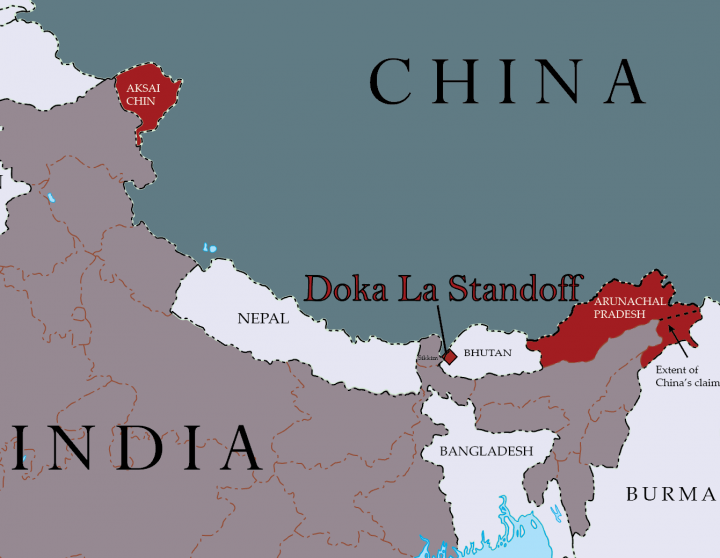By Abdus Sattar Ghazali
China on Monday (March 26) asserted that Doklam belongs to it and India should have learnt lessons from the stand-off last year.
Reacting to India’s Ambassador to China Gautam Bambawale’s remarks blaming China for the stand-off,Chinese Foreign Ministry spokesperson Hua Chunying said, “Donglong (Doklam) belongs to China because we have historical conventions.”
“China’s activities there are within our sovereign rights. There is no such thing as changing status quo. Last year thanks to our concerted efforts and our wisdom we properly resolved this issue. We hope the Indian side could learn some lessons from this and stick to the historical conventions and work with China to ensure the atmosphere in the border areas is conducive for the development of bilateral ties,” she said.
India’s envoy in an interview to Hong Kong-based South China Morning Post had blamed China for the stand-off in Doklam saying it happened because Beijing tried to alter the “status quo” which it should not have.
He had said that any change of status quo along the India-China border may lead to another Doklam-like crisis. He also said that though “no change” has taken place in the standoff site at Doklam after it was resolved last year, the PLA may be reinforcing its troops “well behind the sensitive area”.
Asked about Bambawale’s comments that the 3488-km long Line of Actual Control (LAC) should be demarcated and delineated, the Foreign Ministry spokesperson said on the delimitation China’s position is clear and consistent.
“The east, middle and western side is yet to be officially demarcated. China is committed to resolving the disputes through negotiations. China and India are exploring ways to resolve this territorial dispute through negotiations so that we can arrive at mutually acceptable solution,” she said, referring to the boundary talks between the two countries.
The two sides have so far held 20 rounds of boundary talks. “Pending final solution both sides should work together to maintain peace and tranquility in the border area,” she said.
The Doklam Standoff
In August 2017, both New Delhi and Beijing, with days to go before Indian Prime Minister Narendra Modi would meet Chinese President Xi Jinping at the BRICS summit and G20 meeting in Xiamen, announced a mutual “disengagement” at Doklam. In the days after, observers of the stand-off celebrated what was seen as the conclusion to the Doklam affair.
However, nothing could have been further from the truth, the Diplomat said last October.
Today, the People’s Liberation Army (PLA) remains on disputed territory in Doklam, as does the Indian army. August’s “disengagement” was a reduction in tensions. In practice, troops on both sides retreated their positions from the stand-off point by 150 meters each.
New Delhi successfully attained an outcome where the PLA was unable to extend a road that terminated just 60 meters from the Indian border post at Doka La, but an extended and increasingly robust PLA presence at Doklam is foreboding, according to the Diplomat.
While Xi and Modi were able to maintain face during their meeting in Xiamen at the BRICS and G20 meetings, the mistrust generated in India over the duration of the Doklam crisis will linger, with implications for the development of bilateral ties, the magazine said adding:
“For China, there are good reasons to keep up the heat at Doklam. First, the stand-off made plain to Beijing its quantitative and even qualitative disadvantages against the Indian armed forces in the Himalayas.
“Beijing’s slow but steady build-up on the disputed plateau can serve as an opportunity to rectify this imbalance along this sector of the border, where Indian strategic planners remain particularly concerned given the proximity to the vulnerable Siliguri Corridor – a geographic choke point between northeast India and the rest of the country measuring just 23 km at its narrowest point.
“The silver lining is that despite China’s insistence that India withdraw before diplomacy could take effect, the “disengagement” itself was the result of hard-fought negotiation. The mutually agreed sequential withdrawal was no doubt a positive reduction in the temperature at Doklam, but it remains unclear what concessions either side may be willing to offer to reach a more comprehensive agreement to put an end to the stand-off once and for all.”
What should be clear is that the Doklam stand-off is far from over. What began presumably as a dispute over the extension of a road is now something far greater. It is a test of how India and China will come to manage their relationship and whether each can manage its ambitions in Asia without irreversibly thrusting the bilateral relationship into decline, the Diplomat concluded.
Abdus Sattar Ghazali is the Chief Editor of the Journal of America (www.journalofamerica.net). He is the author of several books including Islam & Muslims in the 21st Century published in 2017.










